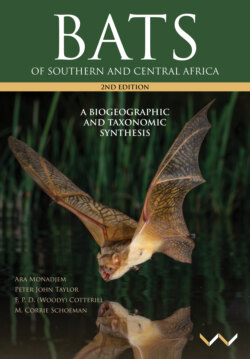Читать книгу Bats of Southern and Central Africa - Ara Monadjem - Страница 21
На сайте Литреса книга снята с продажи.
TORPOR AND HIBERNATION
ОглавлениеAlthough bats are warm-blooded mammals and can maintain a constant body temperature, some show a remarkable degree of thermolability, which occurs on a daily or seasonal basis. The body temperature of torpid bats is colder than that of homeothermic mammals and fluctuates in accordance with the ambient temperature. Daily torpor and hibernation are common in the Vespertilionidae, Rhinolophidae and Hipposideridae, and in some Molossidae (Ransome 1990). Other southern African bats are more conventional thermoregulators and cannot enter torpor.
Bronner et al. (1999) have shown that in the South African lowveld, the Angolan free-tailed bat, Mops condylurus, routinely selects the hottest roosts under tin roofs, and by allowing its body temperature to rise, is able to save energy that would otherwise have been required for cooling (i.e. the reverse of torpor). These same bats readily undergo torpor to conserve energy during daytime roosting in both summer and winter (Vivier and van der Merwe 2007).
Although a few bats migrate to warmer climates for winter, as do some birds, many bats paradoxically move to colder climates for winter (Fleming and Eby 2003). Here, facultative torpor enables these small mammals to shut down their metabolism to a basic level in response to winter cooling, thus allowing their body temperature to fall to that of their environment, or to just above freezing in sub-zero temperatures. The colder the ambient temperature, the greater the energy saved through the lowering of their internal body temperature. By switching off their energy-expensive heating system during hibernation, bats can survive cold winters when insects (i.e. fuel reserves) are very scarce. Prior to hibernating, in late summer, bats will eat voraciously to build up their fat reserves, which may comprise up to 26% of their total body weight just before hibernation. These reserves may have to tide them over for up to six months during hibernation (Fleming and Eby 2003). Bats budget their fat reserves very precisely and forced arousal from hibernation consumes huge amounts of energy reserves, and can result in bats starving before the end of winter. Studies from the northern hemisphere show that one arousal costs the energy that could cover about 60 days of hibernation (Kunz 1982, Kunz and Fenton 2003).
Figure 12. Several species of bat carry their young while foraging. This female Eidolon helvum carrying her young pup was photographed at a large maternity roost on Bat Island, Lake Kivu, Rwanda (© Ian Little).
